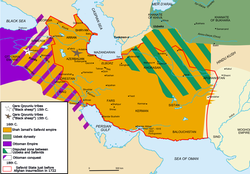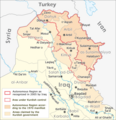Lîsteya xanedan û dewletên kurdan
Xuyakirin
(Ji Dewletên kurdan hat beralîkirin)
| Kurd |
|---|
 |
Ev lîsteyeke xanedan, dewlet û herêmên otonom ên kurdan e. Heta sedsala 10an têgiha "kurd" bi maneyeke etnîkî nedihat bikaranîn û ji koçerên îranî yên li herêma di navbera Gola Wanê û Gola Ûrmiyeyê re "kurd" dihat gotin.[1] Di çavkaniyên erebî yên serdema navîn de, "kurd" ji koçer û nîvkoçerên ku ne faris bûn û ne jî tirk bûn re dihat gotin.[2][3]
Dewletên destpêkî
[biguhêre | çavkaniyê biguhêre]
- Sadaqî (770–827)
- Deysemiyan (938–955)[4]
- Hecbanî (906–1080)
- Hesnewî (912–961)[5]
- Şedadî (951–1199)[6]
- Rewadî (955–1071)
- Hesnewî (959–1014)[7]
- Merwanî (983–1096)[6]
- Enazî (990/91[8]–1117)[8]
- Şivankarî (sedsala 11an–sedsala 12an)[9][10]
- Mîrektiya Gêlê (1049–1864, Bakurê parêzgeha Amedê)[11]
- Hezarhespî (1115–1425)
- Eyûbî (1171–1341)[12]
- Mîrektiya Bedlîsê (1187–1847)
- Mîrektiya Erdelan (sedsala 14an[13]–1865 an 1868[14][15])
- Dewleta Zekarî (1161–1360)[16][17][18]
- Mîrektiya Melkîşî (sedsala 13an–1663)[19]
- Mîrektiya Mukriyan (sedsala 14an–sedsala 19an)[20]
- Xanedana Zarinal (1448–1925)
- Mîrîtiya pazokî (1499–1587)[21]
- Mîrektiya Sileyman (sedsala 15an–1838)
- Mîrektiya Soran (berî 1514an[22]–1836[23])
- Mîrektiya Mîks (?–1846)[24]
Bermahiyên Xanedana Eyyûbiyan (sedsala 13an–sedsala 19an)
[biguhêre | çavkaniyê biguhêre]
Gelek pêkhateyên siyasî yên kurdan di serdema piştî hilweşîna Xanedana Eyûbiyan a di sala 1260an de geş bûn. Hin ji van desthilatdaran îdia dikir ku zuryetên eyûbiyan in.
- Xanedana Xoyê (1210–1799)[25]
- Mîrektiya Çewligê (1231–1864)[26]
- Mîrektiya Hesenkêfê (Mîrektiya Melîkan) (1232[26]–1524[26])
- Mîrektiya Kilîsê[27]
- Mîrektiya Şirwanê (?–1840î)[28]
- Mîrektiya Hekarî (?–1845)[29]
- Xanedana Zirkan (1335–1835)
- Mîrektiya Badînan (1339[30]–1843[31])
- Mîrektiya Botan (?–1833)[31]
- Mîrektiya Mehmûdî (1406–1839)[32]
- Mîrektiya Pinyanîşî (1548–1823)[33]
Herêmên tampon di navbera Osmanî û Îranê de (sedsala 13em–19em)
[biguhêre | çavkaniyê biguhêre]Di dîrokê de ji ber sedemên curbecur, pêkhateyên kurdan wekî herêmên tampon di navbera Împeratoriya Osmanî û Îranê de hebûn. Çend ji wan ev in:
- Xanedana Xoyê (1210–1799)
- Mîrektiya Paloyê (1495–1845)[34]
- Mîrektiya Bradost (1510–1609)[35]
- Mîrektiya Baban (sedsala 16an–1850)[36]
- Xanadiya Tewrêzê (1757–1799)[37]
- Xanedana Hesen Xanî li Pîş-e Kuh (1795–1820)[38]
- Xanadiya Serabê (sedsala 18an) [37]
Xanedanên din ên esil kurd
[biguhêre | çavkaniyê biguhêre]

- Xanedana Hemdaniyan (890-1004) - xanedan ji malbatekî ereb[39] ve hatiye birêvebirin, lê di dema desthilatdariya wan de malbat bi kesên kurd re zewicî, piştî wê jî xanedan bûye kurdî.[40]
- Xanedana Sefewiyan (1501–1736) – Ev xanedan qismen bi eslê xwe kurd bû.[41][42][43]
- Xanedana Zendan (1751-1794) – Xanedan bi eslê xwe kurd lekî bû.[44][45]
Dewletên sedsala 20-21ê
[biguhêre | çavkaniyê biguhêre]- Dewleta Kurd (1918–1919)
- Keyaniya Kurdistanê (1921–1924 û 1925)
- Kurdistana Sor (1923–1929) û Kurdistana Okrug (1930)
- Komara Agiriyê (1927–1931)
- Komara Mehabadê (1946–1947)
- Komara Laçînê (1992)[46]
- Mîrnişîna Îslamî ya Biyare (2001–2003)
Niha
[biguhêre | çavkaniyê biguhêre]- Herêma Kurdistanê (herêma xweser li Iraqê, 1970–heta niha)
- Rêveberiya Xweser a Bakur û Rojhilatê Sûriyê (2012–heta niha)
Nexşe
[biguhêre | çavkaniyê biguhêre]-
Mox (Mok) û Ancewasî (Anjevatsik)
-
Zendiyan
-
Eyûbiyan
-
Keyekseriya Medî
-
Kardox
-
Di peymana Sevrê de Kurdistana serbixwe (1920)
-
Kurdistana Sor (1923–1929)
-
Hikûmeta Herêma Kurdistanê
Mijarên têkildaar
[biguhêre | çavkaniyê biguhêre]Bîbliyografî
[biguhêre | çavkaniyê biguhêre]- Aboona, Hirmis (2008), Assyrians, Kurds, and Ottomans: Intercommunal Relations on the Periphery of the Ottoman Empire, Cambria Press, ISBN 9781604975833
- Baluken, Yusuf (2017), Çend Dokument ji Serdema Mîrektiya Melkîşî, cild 7, Jimar
- Amoretti, Biancamaria Scarcia; Matthee, Rudi (2009). "Ṣafavid Dynasty". Bi Esposito, John L. (edîtor). The Oxford Encyclopedia of the Islamic World. Oxford University Press.
Of Kurdish ancestry, the Ṣafavids started as a Sunnī mystical order (...)
- Matthee, Rudi (2005). The Pursuit of Pleasure: Drugs and Stimulants in Iranian History, 1500-1900. Princeton University Press. rr. 18.
The Safavids, as Iranians of Kurdish ancestry and of nontribal background (...)
- Matthee, Rudi (2008). "SAFAVID DYNASTY". Encyclopædia Iranica.
As Persians of Kurdish ancestry and of a non-tribal background, the Safavids (...)
- Savory, Roger (2008). "EBN BAZZĀZ". Encyclopædia Iranica. Cild VIII. Fasc. 1. r. 8.
This official version contains textual changes designed to obscure the Kurdish origins of the Safavid family and to vindicate their claim to descent from the Imams.
- Başçı, Veysel (2019), "Dunbulî Beyliği Tarihi ve Tarihi Kronikleri [XIII-XVIII. YY.]", Kadim Akademi SBD (bi tirkî), cild 3, rr. 63–114, roja gihiştinê 28 gulan 2020
- Behn, W. (1988), "BĀBĀN", Encyclopedia Iranica, cild III, 3
- Büchner, V. F. (2012), "S̲h̲abānkāra", Encyclopaedia of Islam, Brill Publishers, doi:10.1163/2214-871X_ei1_SIM_5253, ISBN 9789004082656
- Dehqan, Mustafa; Genç, Vural (2019), "The Kurdish Emirate of Brādōst, 1510-1609", Oriente Moderno, cild 99, rr. 306–320, doi:10.1163/22138617-12340222, S2CID 213564665, roja gihiştinê 30 kanûna paşîn 2021
- Ebraheem, Sharameen (2013), The Impact of Architectural Identity on Nation Branding: The Case Study of Iraqi Kurdistan. (PDF), Manchester Metropolitan University's Research Repository
- Eppel, Michael (2018), "The Kurdish emirates", Routledge Handbook on the Kurds, Routledge Handbooks Online, rr. 35–47, doi:10.4324/9781315627427-4, ISBN 978-1-138-64664-3, S2CID 186808301, roja gihiştinê 1 gulan 2020
- Flynn, Thomas O. (2017), The Western Christian Presence in the Russias and Qājār Persia, c.1760–c.1870, Brill Publishers, ISBN 9789004313545
- Ghalib, Sabah Abdullah (2011), The Emergence of Kurdism with Special Reference to the Three Kurdish Emirates within the Ottoman Empire, 1800-1850 (PDF), University of Exeter, ji orîjînalê (PDF) di 17 kanûna pêşîn 2022 de hat arşîvkirin, roja gihiştinê 1 gulan 2020
- Gunter, Michael M. (2010), Historical Dictionary of the Kurds, Scarecrow Press, ISBN 9780810875074
- Hakan, Sinan (2002), Müküs Kürt Mirleri Tarihi ve Han Mahmud (bi tirkî), Pêrî Yayınları, ISBN 9789758245581
- Houtsma, M. Th. (1993), E. J. Brill's First Encyclopaedia of Islam, 1913-1936, Brill Publishers
- Kaplan, Yaşar (2015), Pınyanış Hükümeti/Government of Pinyanish (bi tirkî), Hakkari University
- Maisel, Sebastian (2018), The Kurds: An Encyclopedia of Life, Culture, and Society, ABC-CLIO, ISBN 978-1-4408-4257-3
- Meinecke, Michael (1996), Patterns of Stylistic Changes in Islamic Architecture: Local Traditions Versus Migrating Artists, NYU Press, ISBN 9780814754924
- Petrushevsky, Ilya Pavlovich (1949), Очерки по истории феодальных отношений в Азербайджане и Армении в XVI-начале XIX вв (bi rûsî), Saint Petersburg State University
- Soyudoğan, Muhsin (2015), Tribal Bandistry in Ottoman Ayntab (1690-1730), Bilkent University
- Spuler, B. (2012), "Faḍlawayh", Encyclopaedia of Islam, Brill Publishers, doi:10.1163/1573-3912_islam_SIM_2233, ISBN 9789004161214
- Top, Mehmet (1998), "Hoşaptaki Mahmudi Beylerine Ait Mimari Eserler", Academia SBD (bi tirkî), cild 3
- Verheij, Jelle (30 adar 2018), ""The year of the firman:" The 1895 massacres in Hizan and Şirvan (Bitlis vilayet)", Études arméniennes contemporaines, rr. 125–159, doi:10.4000/eac.1495, ISSN 2269-5281, roja gihiştinê 24 gulan 2020
- Ünal, Mehmet Ali (1999), XVI. yüzyılda Çemişgezek sancağı (bi tirkî)
- Peacock, Andrew (2017). "RAWWADIDS". Encyclopædia Iranica.
RAWWADIDS [...] a family of Arab descent [...] Their Kurdicized descendants ruled over Azerbaijan and parts of Armenia in the second half of the 10th and much of the 11th century.
Çavkanî
[biguhêre | çavkaniyê biguhêre]- Ev gotar ji agahiyên naveroka vê guhertoya gotara wekhev a Wîkîpediyaya îngilîzî pêk tê.
- ^ van Bruinessen, Martin (1989). A. Andrews, Peter (edîtor). "The ethnic identity of the Kurds". Ethnic Groups in the Republic of Turkey: 5.
- ^ Limbert, John (1968). "The Origins and Appearance of the Kurds in Pre-Islamic Iran". Iranian Studies. 1 (2): 48. doi:10.1080/00210866808701350. JSTOR 4309997 – bi riya JSTOR.
- ^ James, Boris (îlon 2006). "Uses and Values of the Term Kurd in Arabic Medieval Literary Sources". Institut Kurde. Roja gihiştinê 4 nîsan 2021.
{{cite web}}: CS1 maint: url-status (lînk) - ^ Bosworth (1994). "Daysam". Iranica Online.
- ^ Tor, D.G. (2017). The Abbasid and Carolingian Empires: Studies in Civilizational Formation. Brill Academic Pub. r. 54-55.
- ^ a b Amir Hassanpour, Nationalism and Language in Kurdistan, 1918-1985, Mellen Research University Press, 1992, p. 50.
- ^ Gunter (2010), r. 117.
- ^ a b Aḥmad, K. M. (1985). "ʿANNAZIDS". Iranica Online. II.
- ^ Büchner 2012.
- ^ Spuler 2012.
- ^ Han, Şeref (Çev. İbrahim Sunkur) (2016). Şerefname. Van: Sîtav. r. 204. ISBN 978-605-66520-1-1.
- ^ R. S. Humphreys, Ayyubids, "Encyclopaedia Iranica", (August 18, 2011),
- ^ Oberling, P. "BANĪ ARDALĀN". Encyclopædia Iranica. Roja gihiştinê 21 îlon 2011.
- ^ David Mcdowall (1996). The Kurds (PDF). Minority Rights Group International Report. r. 20. Roja gihiştinê 2 gulan 2020.
- ^ Najat Abdulla-Ali (2006). Empire, frontière et tribu Le Kurdistan et le conflit de frontière turco-persan (1843-1932) (bi fransî). r. 159.
- ^ Alexei Lidov, 1991, The mural paintings of Akhtala, p. 14, Nauka Publishers, Central Dept. of Oriental Literature, University of Michigan, ISBN 5-02-017569-2, ISBN 978-5-02-017569-3, It is clear from the account of these Armenian historians that Ivane's great grandfather broke away from the Kurdish tribe of Babir
- ^ Vladimir Minorsky, 1953, Studies in Caucasian History, p. 102, CUP Archive, ISBN 0-521-05735-3, ISBN 978-0-521-05735-6, According to a tradition which has every reason to be true, their ancestors were Mesopotamian Kurds of the tribe (xel) Babirakan.
- ^ Richard Barrie Dobson, 2000, Encyclopedia of the Middle Ages: A-J, p. 107, Editions du Cerf, University of Michigan, ISBN 0-227-67931-8, ISBN 978-0-227-67931-9, under the Christianized Kurdish dynasty of Zak'arids they tried to re-establish nazarar system...
- ^ Ünal (1999), rr. 262–263.
- ^ Hassanpour, Amir (1989). "BŪKĀN". Encyclopedia Iranica. IV.
- ^ Han, Şeref (Çev. İbrahim Sunkur) (2016). Şerefname. Van: Sîtav. r. 375. ISBN 978-605-66520-1-1.
- ^ Ghalib (2011), r. 50.
- ^ Ebraheem (2013), r. 235.
- ^ Hakan (2002).
- ^ Başçı (2019), r. 63.
- ^ a b c Maisel (2018), r. 131.
- ^ Soyudoğan (2015).
- ^ Verheij (2018).
- ^ Flynn (2017), r. 663.
- ^ Aboona (2008), r. 175.
- ^ a b Eppel (2018), r. 42.
- ^ Top (1998), r. 6-9.
- ^ Kaplan (2015), r. 4.
- ^ Nusret Aydın, Diyarbakır and Mirdasiler History, 2011, p. 304-305
- ^ Dehqan & Genç (2019).
- ^ Behn (1988).
- ^ a b Tapper, Richard (2010). "Shahsevan".
{{cite journal}}: Ji bo journal parametreya|journal=hewce ye (alîkarî) - ^ Dehqn, Mustafa (2009). "Arkawāzī and His Baweyaļ: A Feylî Elegiac Verse from Piştiku". Iranian Studies. 42 (3): 409–422. doi:10.1080/00210860902907362. JSTOR 25597563.
- ^ Canard, M. (24 nîsan 2012). "Ḥamdānids". Encyclopaedia of Islam, Second Edition (bi îngilîzî). Brill.
- ^ Kennedy, Hugh N.; Barbir, Karl (2004). The Prophet and the Age of the Caliphates: The Islamic Near East from the Sixth to the Eleventh Century (bi îngilîzî). Pearson/Longman. ISBN 978-0-582-40525-7.
- ^ Matthee 2005; Matthee 2008.
- ^ Amoretti & Matthee 2009.
- ^ Savory 2008.
- ^ Perry, John. "ZAND DYNASTY". iranicaonline.org (bi îngilîzî). Encyclopædia Iranica. Roja gihiştinê 24 adar 2017.
The founder of the dynasty was Moḥammad Karim Khan b. Ināq Khan (...) of the Bagala branch of the Zand, a pastoral tribe of the Lak branch of Lors (perhaps originally Kurds; see Minorsky, p. 616) (...)
- ^ ...the bulk of the evidence points to their being one of the northern Lur or Lak tribes, who may originally have been immigrants of Kurdish origin., Peter Avery, William Bayne Fisher, Gavin Hambly, Charles Melville (ed.), The Cambridge History of Iran: From Nadir Shah to the Islamic Republic, Cambridge University Press, 1991, ISBN 978-0-521-20095-0, p. 64.
- ^ Kemper, Michael; Conermann, Stephan (2011). The Heritage of Soviet Oriental Studies. Routledge. r. 92. ISBN 978-1-136-83854-5.
In 1992 the area of Laçin was occupied by Armeian forces; a "Kurdish Republic of Laçin" was subsequently declared by local Kurds, but this remained a rather short-lived - not to say stillborn - adventure








